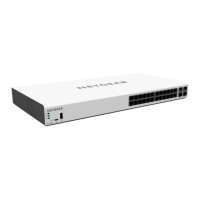
Do you have a question about the NETGEAR GC728X and is the answer not in the manual?
| Model | GC728X |
|---|---|
| Category | Switch |
| Ports | 28 |
| SFP Ports | 0 |
| Power over Ethernet (PoE) | No |
| Layer | L2+ |
| Switching Capacity | 56 Gbps |
| MAC Address Table Size | 16K |
| Rack Mountable | Yes |
| Form Factor | Rackmount |
| Operating Temperature | 0° to 50°C (32° to 122°F) |
| Product Type | Managed |
| SFP+ Ports | 4 |
| Jumbo Frame Support | 9K |
| Dimensions | 17.3 x 8.5 x 1.7 in (440 x 216 x 44 mm) |
| Management | Web GUI |
| AC Power Supply | 100-240V AC, 50/60Hz |
Describes how to manage the switch using the Insight app, Cloud portal, or local browser interface.
Provides methods to connect to the switch via network or directly, including on-network and off-network access.
Covers displaying and specifying basic switch information like IP address, system clock, and DNS.
Details how to configure IP address, subnet mask, and default gateway for the switch's network interface.
Details how to view, configure, and monitor physical port information, including speed, duplex, and description.
Covers the creation, management, and configuration of Virtual Local Area Networks (VLANs) for network segmentation.
Guides on how to enable the switch's routing capabilities for traffic forwarding through its interfaces.
Covers configuring global routing settings for IPv6, including address and prefix management.
Explains how to configure Class of Service (CoS) queueing for traffic prioritization based on packet criteria.
Explains how to add, rename, or delete DiffServ classes and define match criteria for packet classification.
Details how to create DiffServ policies by associating classes and attaching them to switch interfaces.
Covers login password, RADIUS, TACACS+, and authentication list configurations.
Details TACACS+ settings for centralized user management and secure protocol exchanges.
Covers configuring HTTP and HTTPS access, including session timeouts and maximum sessions.
Details configuring port access control using 802.1X, including global and per-port settings.
Explains how to lock ports, define allowable MAC addresses, and manage violations for enhanced port security.
Covers creating and applying ACLs for IPv4, IPv6, and MAC addresses to control traffic flow and enhance security.
Explains how to reset the switch to factory default values, erasing all custom configurations.